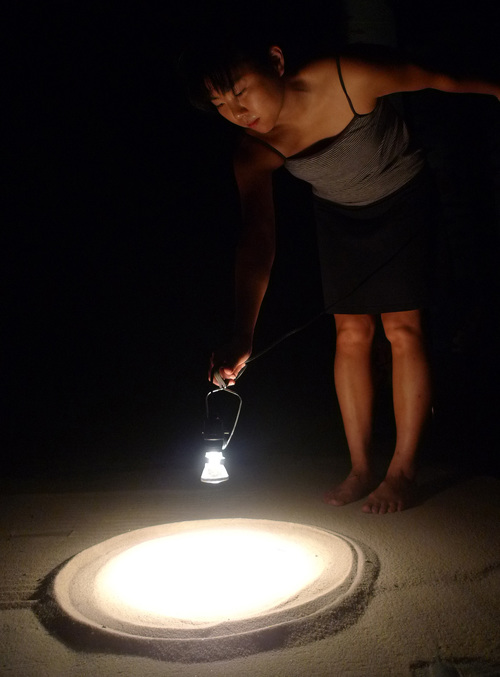| This Friday night in a departure from their typical programming, Trustus Theatre opens Kimi Maeda's Ephemera Trilogy, a piece of performance art based in puppetry, but delivering so much more than an adult puppet show. Staged in three parts and using performance art methodologies that include flashlights, sand, shadow art, and more, the performance will take place at the Trustus Side Door Theatre and will run from April 22nd through May 7th on Thursdays at 7:30, Fridays and Saturdays at 8 pm, and on Sundays at 3. Jasper asked artist Kimi Maeda a few brief questions to better prepare us for receiving her work. Here's what we learned:
... Jasper: Jasper has been following your work on the Ephemera project for a while, but for our readers who are just learning about this project can you please summarize what the project is about? Kimi: In The Ephemera Trilogy, I use shadows and sand to capture the strangeness of living in between two different cultures. Japanese folktales combine with stories of my mother coming to America, and archival footage from Japanese American relocation camps are intercut with sand drawings of my father as a young boy. The constant desire for Home and a unified Identity that always seems to be just out of reach. ... Jasper: This is a trilogy, right? How is it divided and what should viewers expect from each section? Kimi: I see The Homecoming as a short shadow puppet overture to the other two pieces, and so I have placed it at the beginning of the evening. Themes that get introduced will be revisited and elaborated upon later. The Crane Wife provides several re-readings of a Japanese tale in which a crane transforms into a woman, combining it with my own experience growing up as a Japanese American in a white New England town and my mother’s experience immigrating to the United States. It utilizes an overhead projector, mounted and hand-held lights, paper cut-outs, fabric collages, three-dimensional objects, and even my own body to cast shadows. Using sand, shadow, and projection Bend tells the true story of two men incarcerated in a Japanese American relocation camp during World War II: my father, an Asian Art historian who suffered from dementia at the end of his life, and the subject of his research, Isamu Noguchi, a half-Japanese-half-American sculptor. ... Jasper: You created this completed project over six years, is that correct? Was the project fully formed when you began it or did the trilogy aspect present itself to you in the process? Kimi: When I began working on these pieces I had no idea of the scope that the entire project would take. Like a lot of artists, I think there are certain themes that I gravitate toward: Home, trans-cultural identity, and memory. While The Crane Wife focuses on my mother’s story, Bend focuses on my father. After I created Bend it seemed natural that the pieces should fit together. I create work as a way of understanding my place in the world. As I get older I learn new things and try to incorporate that into my work. ... Jasper: And you've had the opportunity to tour this performance, is that correct? Can you tell us a bit about taking the project on the road -- where you've been and what that experience was like? Kimi: There are many different themes in Bend and so I think people connect to it in different ways. When I took it to the International Sonoran Desert Alliance in Ajo, Arizona, as well as the Crossing the Borders: Puppets in the Green Mountains Festival in Putney, Vermont, the topic of immigration was very much on people’s minds. In Arizona it was powerful not only to be in the desert landscape that my father experienced when he was interned, but also to hear the stories related to the border. Taking Bend to Arkansas and the former site of one of the internment camps was also an amazing experience. All that’s left of the camp is a smokestack at the edge of a cotton field. The only Japanese American in the audience was a man who had been born in the camp. His family was one of only seven that stayed in Arkansas when the camps were closed, and his was the only family that remained permanently. It was moving to hear audience members talk about asking their parents why the US government had incarcerated its own citizens. Before I began my last tour the Mayor of Roanoke, VA wrote in reference to Syrian refugees that “President Franklin D. Roosevelt felt compelled to sequester Japanese foreign nationals after the bombing of Pearl Harbor, and it appears that the threat of harm to America from ISIS now is just as real and serious as that from our enemies then.” As more survivors of the camps pass away, I think it becomes more vital than ever that we remember the injustice and we make sure that it never happens again. I wrote this Facebook post before I started the last tour:
Jasper: Finally, is this it? Is this project completed and are you moving on to something else now? Or will there be another part to Ephemera? If you're moving on, do you know what your next project will be or can you give us some hints to what you're thinking of? Kimi: I don’t know that there will be another part to ephemera, but I think the piece as a whole will continue to grow as I get older. Even returning to The Crane Wife after six years I feel as though I’m in a very different place emotionally and intellectually, and so I’ve added a whole new section at the end to try to address this.
Purchase tickets here. |
×



